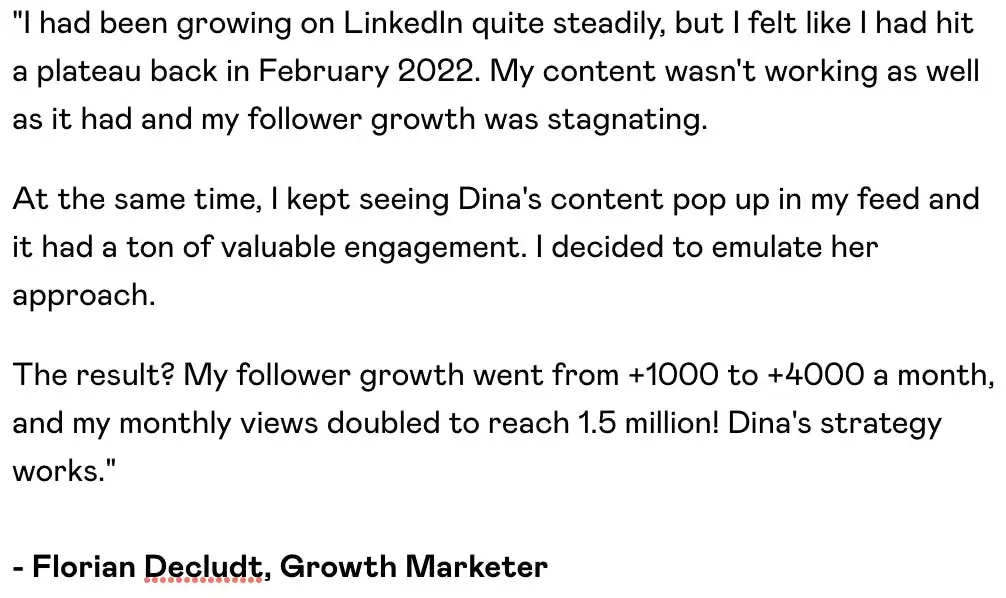Back in Oct 2020, I started posting on LinkedIn with 700 followers, ZERO disposable income for ad spend, and no interest of getting involved in some dodgy shit like pods. No business network, followers on other platforms, or fancy marketing tactics. Nada.
My starting point was a joke, but my ambition was real. So I knew there’s only one way to succeed – write.
Fast forward 27 months and 500 posts, I developed a 5-Step Writing Process you can steal today to monetise your account.
Let me explain the process using the post below.

Step 1. The Goal.
Always have a goal before you start writing. What are you trying to achieve with your post? Generate demand for your coaching, consulting, ebook, or something else? Make sure to tie your content goals & sales goals together each time you write.
For instance, we write LinkedIn profiles for top tier professionals, so this post’s goal was to generate more leads for our profile writing service.
Rule of thumb: 1 post = 1 goal.
Step 2. The Message.
Once you have the goal of your post in mind, it’s time to zoom in.
Which specific message do you want to send to your target audience? In this case, the message I was trying to convey was that using familiar terms in the copy of your LinkedIn profile helps you stand out, as opposed to the general terms most people use.
Rule of thumb: 1 post = 1 message.
Step 3. The Body.
Ok, now that you know your goal, and the message you want to deliver, it’s finally time to write. I usually start with the Body of my post. That’s the part where you convey the message, i.e. give actionable advice to your audience, talk about their greatest misconceptions, or challenge them to think differently.
In this post, I came up with five examples of general vs. familiar terms one could use in their copy;

Pro Tip: Use examples whenever possible. It’ll help your audience understand better, and further showcase your expertise.
Step 4. The Hook.
The Hook is the part of your post that people see before clicking on “see more”, and the most important one. Because it doesn’t matter how good the body of your post is – if no one reads it, it’s like it doesn’t exist. So make sure you spend the most of your time writing the hook that will stop the scroll, and compel the reader to keep on reading.
Let’s take a look at the Hook I used.

There are four important elements of this Hook;
- “cheat code” – Our brains like to take shortcuts whenever they can. So we’ll naturally want to find out what the “cheat code” is.
- “memorable” – Everybody wants to stand out. Especially when it comes to their LinkedIn profiles. This huge benefit was communicated already in the first sentence of the post.
- “avoid” – All of us are afraid of making mistakes. You’re suggesting I should avoid something? I’d better read.
- “for instance” – People love examples. They can paint the picture better than a thousand words. As I already mentioned above, use them whenever possible.
See now why this Hook was so effective?
It generated 132,548 impressions, 1,283 likes, 263 comments, and 14 reposts.

And yes, creating effective Hooks like this one is HARD work. It takes lots of time & effort, and you don’t even know whether it’ll work or not. That’s why we created 67 Hook Templates with Examples, that you can just copy-paste, and piggyback off our hard work. They’ve generated massive results time and again.
Why wing it? Apply what already works.
Step 5. The Ending.
A post Ending is so pivotal to the success or failure of your LinkedIn content that it’s easy to take it for granted.
A good hook will draw the reader in, but a strong ending will make them remember.
Basically, your job here is to either summarise the post, challenge, or motivate the reader.
Let’s get back to my post.

Why does this Ending hit home? Because every business owner out there wants to trigger their target clients’s emotions. If you manage to do that, 70% of the sale is already done.
Now, you might not be sure how to write a strong, persuasive Ending. Worry not. We included our most successful Ending Templates as one of the three Bonuses in the 67 Hook Templates with Examples Bundle. You can just plug-n-play the templates, and end your posts like a Pro.
That’s it.
You’re now officially ready to kick ass on LinkedIn.
Yup. You can doett.
See you in a week. In the meantime, apply this 5-step process. It works.
Your No.1 fan,
Dina
P.S. This is what people say about the Bundle:


